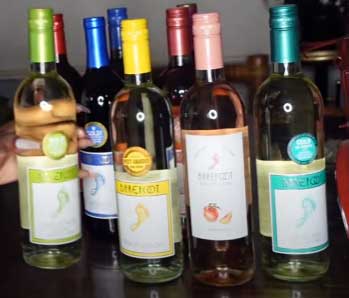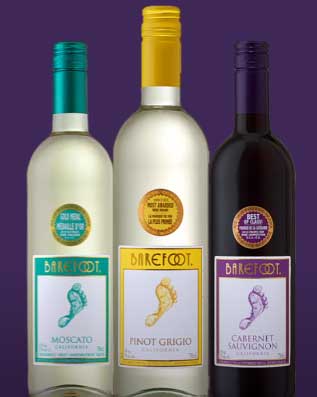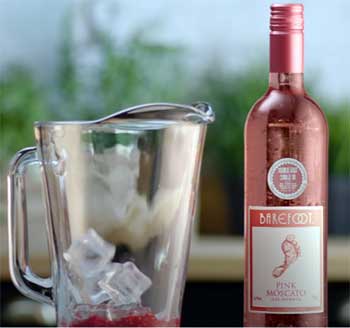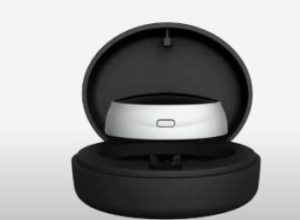Have you ever found yourself perusing the wine aisle at your local grocery store, searching for a bottle that won’t break the bank but still tastes decent?
Chances are, you’ve come across Barefoot Wine. This ubiquitous brand has become a go-to for many budget-conscious wine drinkers, but have you ever wondered why Barefoot Wine is so cheap?
In this article, we’ll dive into the reasons behind the affordability of this popular wine brand and explore whether cheap really means low quality.
Reasons For Barefoot Wine Being So Cheap
Here is a list of those reasons:
- The Power of Mass Production
- Sourcing Grapes from Various Regions
- Focusing on Popular Varietals
- Minimizing Aging Time
- Efficient Distribution and Marketing
- Leveraging Technology and Automation
- Offering a Wide Range of Packaging Options
- Maintaining a Strong Brand Identity
Let’s talk about those reasons in detail.
- The Power of Mass Production

One of the primary reasons Barefoot Wine is able to keep its prices low is due to the sheer scale of its production.
Barefoot is owned by E&J Gallo Winery, the largest family-owned winery in the United States.
With such a massive operation, Barefoot can produce wine in enormous quantities, which allows them to keep their costs down through economies of scale.
When a winery produces large volumes of wine, they can spread out their fixed costs (such as equipment and facilities) over a greater number of bottles. This means that the cost per bottle is lower than it would be for a smaller winery producing a limited quantity of wine.
Additionally, large-scale producers like Barefoot can negotiate better prices for their grapes and other raw materials due to their purchasing power.
- Sourcing Grapes from Various Regions
Another factor contributing to Barefoot’s affordability is their sourcing strategy. Unlike some wineries that grow their own grapes or source from a single vineyard, Barefoot buys grapes from various regions across California and beyond.
This approach allows them to take advantage of lower grape prices in certain areas and ensures a consistent supply of grapes for their production.
By not being tied to a specific vineyard or region, Barefoot has the flexibility to choose grapes that meet their quality standards while still being cost-effective. This strategy also helps to mitigate the risk of crop failures or price fluctuations in any one area, as they can simply source from another region if necessary.
- Focusing on Popular Varietals
Barefoot Wine focuses primarily on producing popular varietals that have wide appeal among consumers. Their lineup includes classics like Cabernet Sauvignon, Merlot, Chardonnay, and Pinot Grigio, as well as trendy options like Moscato and Pink Moscato.
By concentrating on these crowd-pleasing styles, Barefoot can streamline their production process and avoid the added costs associated with producing more niche or obscure varietals. This approach also helps to ensure a consistent demand for their products, as these popular varietals are more likely to sell quickly and in larger quantities.
- Minimizing Aging Time

One of the most significant factors in the cost of wine is the amount of time it spends aging.
Many high-end wines are aged for years in expensive oak barrels, which can add substantially to the final price of the bottle.
Barefoot, on the other hand, minimizes aging time for most of their wines, opting instead to release them young and fresh.
By reducing the amount of time their wines spend in barrels or bottles before hitting the shelves, Barefoot can keep their production costs down and pass those savings on to the consumer.
While this approach may not result in the most complex or nuanced wines, it does allow for a more affordable product that still delivers on flavor.
- Efficient Distribution and Marketing
Barefoot’s widespread availability and recognizable branding are also key factors in their ability to keep prices low. As part of the E&J Gallo Winery portfolio, Barefoot benefits from an extensive distribution network that allows their wines to be easily found in grocery stores, liquor stores, and even convenience stores across the country.
This efficient distribution system, combined with effective marketing campaigns and eye-catching labels, helps Barefoot maintain a strong presence in the market without the need for expensive advertising or promotion.
By keeping their distribution and marketing costs in check, Barefoot can continue to offer their wines at budget-friendly prices.
- Leveraging Technology and Automation
In addition to mass production and efficient sourcing strategies, Barefoot Wine also relies on advanced technology and automation to keep their costs down.
The company has invested in state-of-the-art equipment and production facilities that allow them to streamline their winemaking process and minimize labor costs.
For example, Barefoot utilizes automated bottling lines that can fill, label, and package their wines at an impressive speed. This technology not only reduces the need for manual labor but also ensures consistency in the final product.
By minimizing the potential for human error and increasing efficiency, Barefoot can maintain their low prices without sacrificing quality control.
Moreover, the company employs sophisticated monitoring systems to track various aspects of the winemaking process, such as temperature, pH levels, and fermentation progress. This allows them to make real-time adjustments and optimize their production, further reducing the risk of costly mistakes or wasted resources.
- Offering a Wide Range of Packaging Options
Another factor contributing to Barefoot’s affordability is their diverse range of packaging options. In addition to traditional 750ml glass bottles, the company offers their wines in various formats, including boxed wine, cans, and smaller 187ml single-serving bottles.
These alternative packaging options not only appeal to a wider range of consumers and consumption occasions but also help to keep costs down.
For instance, boxed wine is cheaper to produce and transport than glass bottles, as it is lighter and more compact. This allows Barefoot to pass on the savings to their customers while still providing a convenient and portable option for enjoying their wines.
Similarly, the smaller 187ml bottles are perfect for single servings or on-the-go consumption, catering to the growing demand for more flexible and accessible wine options.
By offering these diverse packaging choices, Barefoot can attract budget-conscious consumers who may be looking for more affordable alternatives to traditional bottled wine.
- Maintaining a Strong Brand Identity

Finally, Barefoot’s strong brand identity and customer loyalty play a significant role in their ability to keep prices low.
Over the years, the company has cultivated a fun, approachable, and inclusive brand image that resonates with a wide range of consumers.
Through consistent branding, marketing campaigns, and sponsorships of events like beach cleanups and music festivals, Barefoot has positioned itself as a laid-back, unpretentious wine brand that celebrates the simple joys of life.
This brand identity has helped to foster a sense of loyalty among their customers, who appreciate the company’s values and commitment to accessibility.
As a result, Barefoot benefits from strong brand recognition and a reliable customer base, which allows them to maintain steady sales volumes and keep their prices competitive.
By building and maintaining this strong brand identity, Barefoot can continue to thrive in the budget-friendly wine market without the need for expensive marketing campaigns or drastic price adjustments.
- The Question of Quality
Now that we’ve explored the reasons behind Barefoot’s affordability, you might be wondering whether cheap prices necessarily mean low quality. The answer, as with most things in the world of wine, is somewhat subjective.
It’s important to remember that Barefoot Wine is designed to be an everyday, easy-drinking wine. They’re not aiming to compete with premium, small-batch producers or to create the most complex, age-worthy wines on the market.
Instead, their goal is to provide a consistent, enjoyable product at a price point that’s accessible to a wide range of consumers.
That being said, Barefoot has managed to garner a loyal following and has even won some awards for their wines. In 2020, for example, their Moscato was awarded a gold medal at the San Francisco Chronicle Wine Competition, while their Pinot Grigio and Sauvignon Blanc both earned silver medals.
While these accolades may not place Barefoot in the same category as some of the world’s most prestigious wineries, they do suggest that the brand is capable of producing quality wines within their price range.
Ultimately, the perception of quality will depend on the individual consumer’s tastes, preferences, and expectations.
Frequently Asked Questions (FAQ)
Yes, Barefoot wine is generally considered to be an affordable, budget-friendly option. Their wines typically retail for around $5 to $10 per bottle, depending on the varietal and location.
The quality of Barefoot wine is subjective and depends on individual taste preferences. While they may not compare to premium, small-batch wines, Barefoot has won some awards and has a loyal following among casual wine drinkers who appreciate their consistency and value.
Comparing Yellow Tail and Barefoot is largely a matter of personal preference. Both brands offer affordable, easy-drinking wines that are widely available. Some people may prefer the flavor profiles of one brand over the other, but there is no definitive answer as to which is better.
Like many mass-produced wines, Barefoot may use various additives and fining agents to ensure consistency and stability across their large-scale production. These can include sulfites, which are commonly used as preservatives, as well as other substances like bentonite clay or egg whites for clarification. However, the specific additives used in Barefoot wines are not readily disclosed by the company.
Wrapping Up
In conclusion, Barefoot Wine’s affordability can be attributed to a combination of factors, including mass production, flexible grape sourcing, a focus on popular varietals, minimal aging, and efficient distribution and marketing.
By leveraging these strategies, Barefoot has positioned itself as a budget-friendly option for casual wine drinkers who prioritize value and consistency over complexity and rarity.
While some wine enthusiasts may turn their noses up at the idea of cheap wine, it’s hard to deny the appeal of a brand like Barefoot. Their wines offer a simple, unpretentious way to enjoy a glass without the need for extensive knowledge or a hefty price tag.
So, the next time you find yourself reaching for a bottle of Barefoot, you can appreciate the thought and strategy that goes into making this affordable wine a reality.



